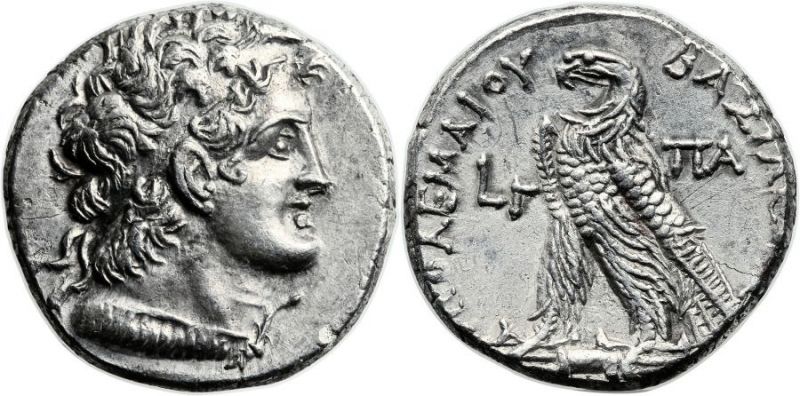Paphos (Ptolemy X), silver, tetradrachms (114-105 BCE) Olivier
From SILVER
114 BCE - 105 BCE Silver 8,178 kg
Description
| ObverseInscription or printing placed on the obverse.: | Head of Ptolemy I Soter to right, wearing diadem and aegis around neck. |
| ReverseInscription or printing placed on the reverse.: | ΠΤΟΛΕΜΑΙΟΥ ΒΑΣΙΛΕΩΣ (Greek).Eagle standing left on thunderbolt, LΓ (date) in left field, ΠA in right field |
Mint and issuing power
| MintIdentifies the place of manufacture or issue of a numismatic object.: | Paphos | Ancient regionAncient region.: | Cyprus | Modern countryModern country: Greece | AuthorityIdentifies the issuing power. The authority can be "pretended" when the name or the portrait of X is on the coin but he/she was not the issuing power. It can also be "uncertain" when there is no mention of X on the coin but he/she was the issuing power according to the historical sources: | Ptolemaic dynasty (323-30 BC), Ptolemy I Soter (satrap and Ptolemaic king of Egypt, 323-305 BC), Ptolemy X Alexander I (Ptolemaic king, 110-88 BC) |
Chronology
| FromIdentifies the initial date in a range assigned in a numismatic context. | 114 BCE | toIdentifies the final date in a range assigned in a numismatic context.. | 105 BCE | PeriodTime period of the numismatic object.: Hellenistic 323-30 BC |
Physical description
| MetalThe physical material (usually metal) from which an object is made.: | Silver |
Median weightMedian of the weights of numismatic objects (in grams). in grams | 14.10 | DenominationTerm indicating the value of a numismatic object. Examples: tetradrachm, chalkous, denarius.: | tetradrachm |
StandardStandard.: | Ptolemaic |
Image

H322 Paphos Ptolemy X.jpg [1]
References
| Die study referencePublication of the study: | Olivier 20121Olivier 2012, p. 128-132, n° 2361-2525 | ||
| Coin series referenceReference to coin series study: | RQEMH2RQEMH, n° 322 | ||
Obverse dies distribution
| FrequencyFrequency of specimen in distribution. ᵖ | Number of obversesNumber of obverse dies. ᵖ (o) | % (o) | Number of coinsNumber of coins. (n) | % (n) | Die nameName(s) of the die(s). |
| 1 | 9 | 33.33 | 9 | 5.45 | 394, 396, 405, 406, 407, 415, 416, 417, 418 |
| 2 | 6 | 22.22 | 12 | 7.27 | 404, 408, 409, 411, 412, 413 |
| 3 | 2 | 7.41 | 6 | 3.64 | 402, 410 |
| 4 | 3 | 11.11 | 12 | 7.27 | 399, 414, 419 |
| 7 | 1 | 3.7 | 7 | 4.24 | 395 |
| 11 | 1 | 3.7 | 11 | 6.67 | 397 |
| 12 | 1 | 3.7 | 12 | 7.27 | 403 |
| 19 | 1 | 3.7 | 19 | 11.52 | 398 |
| 24 | 1 | 3.7 | 24 | 14.55 | 400 |
| 25 | 1 | 3.7 | 25 | 15.15 | 393 |
| 28 | 1 | 3.7 | 28 | 16.97 | 401 |
| Total | 27 of 27 | 99.97 | 165 of 165 | 100 |
Reverse dies distribution
no distribution is available
Quantification
| Number of obversesNumber of obverse dies. ᵖ (o) | 27 | Number of singletons (o1)The number of singleton coins. ᵖ | 9 |
| Number of reverse diesNumber of reverse dies. (r) | 89 | Number of coinsNumber of coins. (n) | 165 |
| Coins per obverse dieNumber of coins per obverse die. (n/o) | 6.11 | Coins per reverse dieNumber of coins per reverse die. (n/r) | 1.85 |
| Reverse per obverse ratioRatio of obverse dies divided by reverse dies. (r/o) | 3.3 | Percentage of singletons (o1)number of coins (n) divided by the number of singletons (o1) ᵖ | 33.33 % |
| Original number of dies (O) (Carter 1983 formula)The estimation of the number of coins according to Carter 1983 ᵖ | 29 | Coins struck if 20,000 as average productivity per dieCoins made if the average productivity for obverses (according to Carter) is 20,000. ᵖ | 580,000 |
| Original number of dies (O) (Esty 2011 formula)The estimation of the number of coins according to the singleton formula in Esty 2011 ᵖ (O) | 32.28 | Survival rate if 20,000 as average productivity per dieSurvival rate if average productivity is 20,000. ᵖ | 0.00028 |
| Coverage (o = % of O) (Esty 1984 formula)Esty 1984 - coverage (% of O) ᵖ (o = % of O) | 94.55% | Die productivity if survival rate 1/2,000Average productivity if survival rate is 1/2,000. ᵖ | 11,379.31 |
| Weight of silver (in kg) if 20,000 coins per die (O = Carter formula)Carter 1983 * Median weight * 20000 (*10 if gold or electrum) ᵖ | 8,178 kg <br /> 8,178 kg | Die productivity if survival rate 1/5,000Average productivity if survival rate is 1/5,000. ᵖ | 28,448.28 |
Remarks